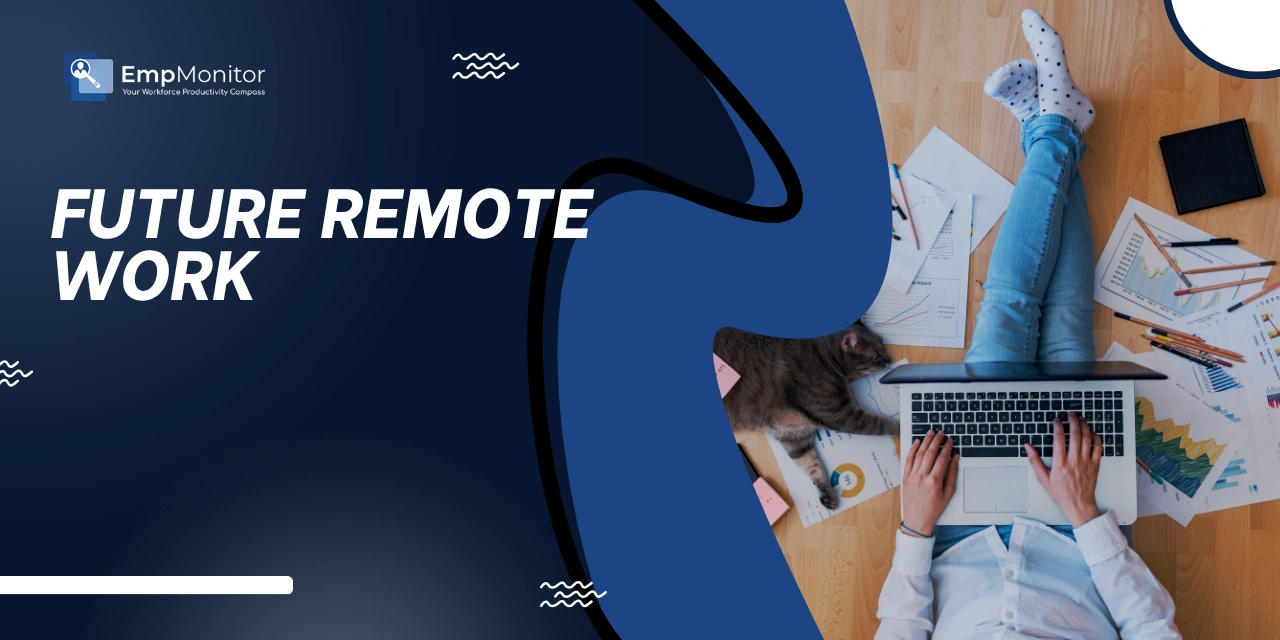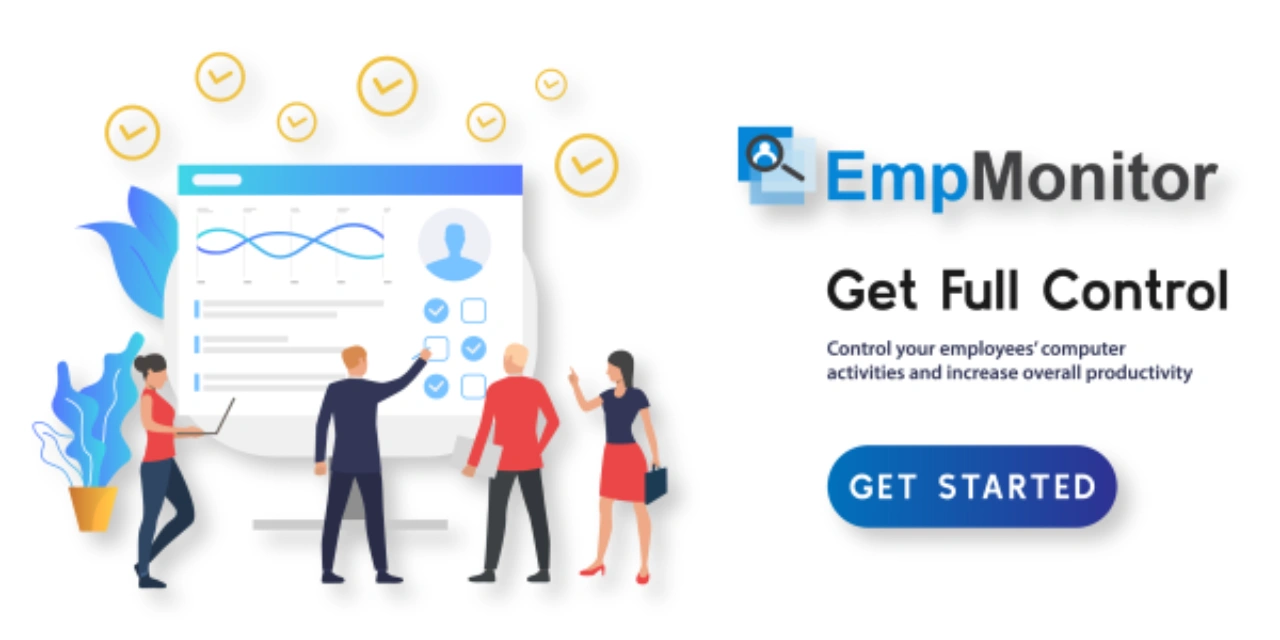The future of Remote work is now a reality, not just a dream. As technology grows smarter and people rethink what they want from their jobs, the idea of being tied to a desk from 9 to 5 is quickly fading. More teams are choosing flexibility, and more companies are learning that results matter more than location.
This guide is your go-to resource for understanding where remote work is headed in 2025 and beyond. We’ll break down the trends, predictions, and tech shaping this shift, plus how tools like EmpMonitor and other remote work software are helping teams stay connected and productive from anywhere. Whether you’re leading a team, managing people, or simply figuring out how to thrive while working remotely, you’ll find practical insights to help you stay ahead.
Listen To The Podcast Now!
What Is the Future of Remote Work? 
So, what is the future of remote work? The answer lies in a blend of flexibility, technology, and a shift in workplace culture. The future of Remote work has gone from a niche concept to a mainstream model adopted by companies worldwide. The focus is no longer just on allowing employees to work from home, but on building an ecosystem where they can thrive, wherever they are.
In the coming years, we’ll see the future of remote work evolve into something more holistic. It will no longer be about simply replicating office work at home but reimagining how work gets done altogether. This includes changes in leadership style, communication methods, performance metrics, and even the tools we use to stay connected.
What Is The Future Of Remote Work In 2025?
As we look ahead to 2025, it’s clear that remote work will not only continue but also evolve into a more structured and sustainable model. The COVID-19 pandemic may have accelerated the adoption of remote work, but its long-term presence is now driven by both business needs and employee preferences. So, what is the future of work in 2025? It’s a blend of flexibility, innovation, and intentional workplace design.
By 2030, the future of remote work will likely become a default option for many industries, especially in technology, finance, marketing, and customer service. Hybrid work models, where employees split time between home and the office, will become standard. Companies will focus less on where people work and more on how well they work. The concept of “results over hours” will dominate, emphasizing output, creativity, and collaboration rather than traditional 9-to-5 schedules.
We’ll also see the rise of digital infrastructure designed to support remote work at scale. Tools like AI-powered productivity assistants, remote team management software, and remote work employee monitoring software like EmpMonitor will play a major role. These tools won’t just track activity, they’ll offer insights, improve efficiency, and support employee well-being.
Workplaces will become more inclusive and global. With geography no longer a barrier, companies can access talent from anywhere in the world, building diverse, distributed teams. This global workforce will bring new perspectives but also require smarter communication, cultural understanding, and time zone coordination.
Employee experience will also take center stage. Businesses will invest in mental health resources, virtual team-building, ergonomic support, and digital upskilling. Organizations that create a thoughtful remote experience, balancing freedom with support, will attract and retain top talent.
In short, the future of remote work is not just about location; it’s about freedom, purpose, and a reimagined way of working that benefits both individuals and organizations.
The Future Of Remote Work Technologies?
As remote work becomes a permanent fixture across industries, technology is evolving to make it smarter, smoother, and more human-centric. It’s no longer just about video calls or cloud access—it’s about empowering people to do their best work from anywhere.
Shortly, intelligent and integrated tools will drive this transformation. AI will take center stage, automating scheduling, summarizing meetings, and even suggesting breaks based on work habits. These features are quickly becoming a reality.
Immersive technologies like VR and AR will bring remote teams into lifelike virtual spaces, enhancing collaboration and reducing the isolation of working from home. At the same time, cybersecurity will grow stronger with tools like biometric logins and real-time threat monitoring.
Monitoring and management tools like EmpMonitor will help organizations maintain productivity and transparency without invading privacy. With smart remote management solutions, companies can support distributed teams more effectively.
Ultimately, the future of remote work technology isn’t about replacing people; it’s about enabling connection, flexibility, and performance more naturally and securely.
How EmpMonitor Is Shaping The Future Of Remote Work?
As we move into a future where remote and hybrid work models are the norm, businesses are looking for smarter ways to manage distributed teams, maintain productivity, and ensure accountability, without compromising trust. This is where EmpMonitor plays a vital role.
EmpMonitor is an advanced remote work monitoring software designed to help organizations adapt and thrive in a remote-first world. It offers powerful, user-friendly features that align perfectly with the needs of remote work in 2025 and beyond.
Here’s how EmpMonitor supports the future of remote work:
1. Real-Time Activity Tracking
EmpMonitor gives managers instant access to real-time data on employee activities such as working hours, app and website usage, and idle versus active time. This feature promotes accountability without disrupting workflows. Teams stay focused and on track while still enjoying flexibility in how they work.
2. Productivity Analysis
EmpMonitor’s detailed productivity reports and visual dashboards help identify peak performance hours, trends, and areas where employees may need support. Managers can easily evaluate team performance with data-driven insights. It’s especially valuable for remote or hybrid teams where visibility is limited.
3. Automated Screenshots & Timesheets
To ensure transparency, EmpMonitor automatically captures screenshots and generates timesheets based on actual activity. This reduces the need for manual tracking or constant check-ins. Teams can focus on work while managers get a clear view of progress and accountability.
4. Cloud-Based Accessibility
As a cloud-based solution, EmpMonitor allows managers to access workforce data from any device and location. Whether teams are remote, hybrid, or distributed globally, the platform ensures seamless visibility and centralized control. It supports efficient management from anywhere, at any time.
5. Employee Privacy Controls
EmpMonitor is built with ethical monitoring in mind, offering customizable privacy settings and role-based access. It helps businesses gather meaningful insights while respecting employee boundaries. This balance fosters trust and ensures compliance with data privacy standards.
6. Insider Threat Detection & Data Security
EmpMonitor protects organizations from internal risks by detecting suspicious activities, unauthorized access, or data breaches. With features like data loss prevention, USB activity monitoring, and real-time alerts, it helps secure company assets and maintain operational integrity in remote environments.
In a future of remote work, tools like EmpMonitor do more than just monitor; they empower. By combining visibility, analytics, and flexibility, EmpMonitor helps businesses support remote teams with confidence, trust, and data-driven decisions.
Also Read!
https://empmonitor.com/blog/create-hybrid-work-policy/
What Are Current and Future Work Trends?
The world of work is going through a major transformation. The traditional 9-5 office model is being replaced by flexible, tech-enabled work environments that prioritize well-being, productivity, and purpose. Let’s explore some of the most important current and future work trends shaping the way we work now, and what we can expect shortly.
Current Work Trends
1. Remote and Hybrid Work Models
Remote work has evolved from a temporary fix during the pandemic to a long-term strategy embraced by businesses worldwide. The hybrid model, where employees split their time between working from home and the office, is increasingly popular as it offers the best of both worlds: in-person collaboration and remote flexibility. This trend is helping organizations reduce overhead costs while giving employees greater work-life balance, boosting morale, and retention. It’s in trend because it aligns with the modern workforce’s demand for autonomy and freedom without compromising productivity.
2. Flexible Work Hours
Today’s workforce places a high value on autonomy and personal time, prompting companies to move away from rigid 9-to-5 schedules. Flexible work hours allow employees to work during their most productive times, which can lead to better focus, fewer distractions, and improved outcomes. This trend is on the rise because it supports diverse lifestyles, accommodates global teams in different time zones, and fosters a culture of trust and accountability. Businesses adopting this model often see higher employee satisfaction and lower turnover rates.
3. Outcome-Based Performance
Instead of tracking how many hours employees are online or at their desks, organizations are now focusing on results and deliverables. This shift to outcome-based performance measurement encourages efficiency and creativity, allowing employees to take ownership of their work. It’s trending because it aligns with flexible and remote work models where micromanagement is impractical. This approach not only builds trust but also promotes a culture of meritocracy where performance is judged by impact, not presence.
4. Digital Collaboration Tools
With teams now working across locations and time zones, digital collaboration platforms like Zoom, Slack, Microsoft Teams, Trello, and Asana have become essential. These tools make it easy to communicate, share files, manage projects, and host virtual meetings in real-time. Their rising usage is driven by the need for seamless collaboration in distributed work environments. These platforms enhance productivity, reduce communication gaps, and enable teams to stay aligned and connected regardless of physical location.
5. Increased Focus on Mental Health
Mental health is now being recognized as a critical component of employee well-being and organizational success. Companies are offering resources like mental health days, access to virtual therapy, meditation apps, and wellness programs to support their workforce. This trend is growing because remote work can sometimes lead to isolation and burnout, which affects performance and morale. By prioritizing mental health, employers not only show compassion but also improve engagement, reduce absenteeism, and create a healthier workplace culture.
Future Work Trends
1. AI-Driven Workflows
Artificial intelligence is transforming how we work by automating repetitive tasks like scheduling, data entry, and reporting. It also helps personalize workflows based on employee behavior and preferences. This boosts productivity and frees up teams to focus on strategic, creative work.
2. Virtual Reality Collaboration
Virtual reality is changing the remote work landscape by enabling immersive meetings, brainstorming sessions, and training environments. Teams can collaborate in 3D spaces that feel more natural and engaging than video calls. This makes remote work more interactive and team-oriented.
3. Global Talent Pools
Businesses are no longer limited by geography when hiring. With remote infrastructure in place, companies can tap into talent from around the world. This expands diversity, brings fresh perspectives, and allows businesses to build high-performing teams without location constraints.
4. Remote Work Monitoring & Management Software
As remote work becomes the norm, tools like EmpMonitor are essential for managing distributed teams. These platforms help track productivity, monitor workflows, and ensure accountability, while still respecting privacy. They make remote management efficient, transparent, and ethical.
5. Focus On Digital Skills And Upskilling
With technology evolving fast, companies are investing in digital skills training to stay competitive. Remote learning platforms and upskilling programs help employees grow and adapt to new tools and trends. This focus on continuous learning keeps teams agile and future-ready.
Top 5 Future Remote Work Trends for 2025
The remote work landscape continues to evolve at a rapid pace. As we look ahead to 2025, it’s clear that remote work will not only persist it will become smarter, more flexible, and more people-centric.
Here are the top 5 remote work trends you can expect to see shaping the workplace in 2025:
1. Hybrid-First Becomes The New Standard
In 2025, most organizations will officially adopt hybrid work as the default model, not just as an option. Employees will have the freedom to choose where they work, combining the flexibility of remote work with occasional in-person collaboration. Offices will transform into “collaboration hubs” rather than daily workstations.
2. AI-Powered Productivity And Workflow Automation
Artificial Intelligence will be deeply integrated into daily work routines. From intelligent meeting summaries to AI-powered scheduling and task prioritization, teams will rely on automation to work smarter, not harder. This will reduce manual effort and allow people to focus on more meaningful work.
3. Rise Of Global, Diverse Remote Teams
Remote work eliminates geographical hiring limits. By 2025, companies will increasingly tap into global talent pools, creating diverse and inclusive teams across continents. With this shift comes the need for stronger cultural sensitivity, asynchronous communication, and effective remote team management software.
4. Work-Life Balance And Mental Wellness As Business Priorities
Mental health will take center stage. Companies will build more holistic remote cultures, offering digital wellness programs, flexible hours, mental health support, and time-off policies that help prevent burnout and promote balance.
5. Advanced Remote Work Monitoring And Management Tools
As remote work grows, so does the need for visibility and accountability. Tools like EmpMonitor, a leading remote work monitoring software, will be essential. These platforms provide real-time productivity insights, activity tracking, and timesheet automation, empowering managers to lead remote teams with data, not micromanagement.
The future of remote work in 2025 is not just about working from home; it’s about building smarter, more balanced, and inclusive ways of working. Organizations that embrace these trends will be better positioned to attract top talent, boost productivity, and thrive in the years ahead.
Also Read!
https://empmonitor.com/blog/remote-work-systems/
https://empmonitor.com/blog/future-of-work/
Conclusion
The future of remote work is not just a passing trend; it’s a long-term shift that is redefining how businesses operate and how people work. As we move toward 2025 and beyond, flexibility, technology, and employee well-being will lead the way. Organizations that adapt to this new era by embracing hybrid models, adopting advanced tools like remote work monitoring software and remote team management software, and prioritizing trust and productivity will thrive in a competitive and global talent market.
At its core, remote work is about freedom, balance, and results. With the right mindset and tools, the future of remote work is not just promising, it’s powerful.
FAQ
1. What is the future of remote work?
The future of remote work involves more flexible, hybrid models supported by smart technologies. Companies will focus on results rather than hours worked, and employees will enjoy better work-life balance, remote tools, and digital collaboration platforms.
2. What is the future of remote work in 2025?
By 2025, remote and hybrid work will be the standard for many industries. Businesses will use AI, cloud-based software, and tools like EmpMonitor to manage productivity and support distributed teams across the globe.
3. What technologies will support the future of remote work?
Key technologies include remote work monitoring software, remote management software, virtual collaboration platforms, AI-powered scheduling and analytics tools, and cybersecurity solutions. These help businesses manage and support remote teams effectively and securely.














